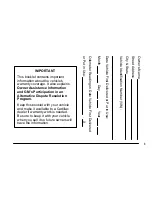
Child restraint system on the front-
passenger seat
General notes
If you secure a child in a child restraint system
on the front-passenger seat, be sure to
observe the instructions and safety notes on
the "Occupant Classification System (OCS)"
(
Y
page 49).
You can thus avoid the risks that could arise
as a result of:
R
an incorrectly categorized person in the
front-passenger seat
R
the unintentional deactivation of the front-
passenger front air bag
R
the unsuitable positioning of the child
restraint system, e.g. too close to the dash-
board
Rearward-facing child restraint system
If it is absolutely necessary to install a rear-
ward-facing child restraint system on the
front-passenger seat, always make sure that
the front-passenger front air bag is deactiva-
ted. Only if the PASSENGER AIR BAG OFF
indicator lamp is permanently lit (
Y
page 41)
is the front-passenger front air bag deactiva-
ted.
Always observe the child restraint system
manufacturer's installation and operating
instructions.
Forward-facing child restraint system
If you secure a child in a forward-facing child
restraint system on the front-passenger seat,
always move the front-passenger seat as far
back as possible. The entire base of the child
restraint system must always rest on the seat
cushion of the front-passenger seat; the rear
side must, as far as possible, be resting on the
backrest of the front-passenger seat. The
child restraint system must not touch the roof
or be subjected to a load by the head
restraint. Adjust the angle of the seat back-
rest and the head restraint position accord-
ingly. Always make sure that the shoulder belt
strap is correctly routed from the front-
passenger seat belt loop to the shoulder belt
guide on the child restraint system. The shoul-
der belt strap must be routed forwards and
downwards from the front-passenger seat
belt loop.
Always observe the child restraint system
manufacturer's installation and operating
instructions.
Pets in the vehicle
G
WARNING
If you leave animals unattended or unsecured
in the vehicle, they could press buttons or
switches, for example.
As a result, they could:
R
activate vehicle equipment and become
trapped, for example
R
activate or deactivate systems, thereby
endangering other road users
Unsecured animals could also be flung around
the vehicle in the event of an accident or sud-
den steering or braking, thereby injuring vehi-
cle occupants. There is a risk of an accident
and injury.
Never leave animals unattended in the vehi-
cle. Always secure animals properly during
the journey, e.g. use a suitable animal trans-
port box.
Driving safety systems
Overview of driving safety systems
In this section, you will find information about
the following driving safety systems:
R
ABS (
A
nti-lock
B
raking
S
ystem)
(
Y
page 60)
R
BAS (
B
rake
A
ssist
S
ystem) (
Y
page 60)
R
COLLISION PREVENTION ASSIST PLUS
(
Y
page 61)
Driving safety systems
59
Saf
ety
Z
Summary of Contents for GT S 2016
Page 4: ......
Page 70: ...68...
Page 88: ...86...
Page 98: ...96...
Page 160: ...158...
Page 184: ...182...
Page 185: ...Useful information 184 Stowage areas 184 Features 186 183 Stowage and features...
Page 200: ...198...
Page 210: ...208...
Page 268: ...266...
Page 269: ...267...
Page 270: ...268...
















































